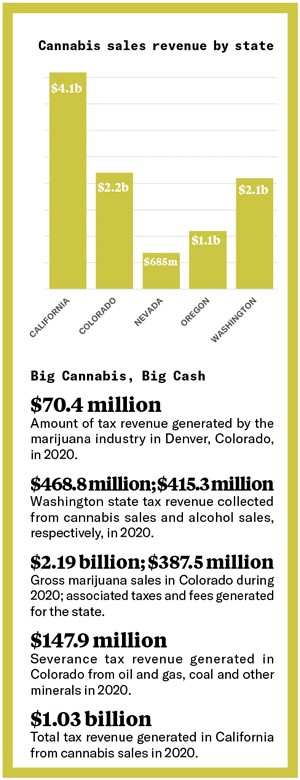Cannabis has a carbon problem
The burgeoning marijuana industry gobbles up electricity
High Country News
Jonathan Thompson
May 31, 2021 From the print edition
Location, location, location: That’s the deciding factor when it comes to the size of marijuana cultivation’s carbon footprint, according to a new study out of Colorado State University.
The paper’s authors, led by Hailey Summers, confirmed previous findings that indoor pot-growing gobbles up huge amounts of electricity and can cause high greenhouse gas emissions. Their research also quantifies emission differences from place to place: A kilogram of cannabis cultivated in Long Beach, California, for example, has a smaller carbon footprint than one grown in Denver, Colorado.
The reason? More energy is required to keep the indoor temperature and humidity at optimum levels in very cold or hot places than in more temperate areas. And California’s grid is virtually coal-free, while the power grid in Colorado and other Interior West states relies heavily on coal and natural gas, both of which emit large amounts of greenhouse gases.

OREGON
7: Number of power outages attributed to grow operations on Portland’s grid during the first summer after recreational marijuana was legalized in Oregon.
$52,000: Estimated annual utility bill savings a Portland marijuana cultivator realized by installing high-efficiency HVAC systems in its 36,000-square-foot facility. The equipment reduced carbon emissions by about 380 tons annually.
CALIFORNIA
2,283: Kilograms of carbon emissions from growing one kilogram of cannabis in Long Beach, California.Kaneohe Bay, Hawaii, respectively, the lowest and highest in the United States. Power generation in Hawaii is mostly fueled by oil.
COLORADO
733,200 mwh: Estimated yearly electricity consumption by Colorado’s marijuana cultivators.
76,400: Estimated number of Colorado households that amount of energy could power for a year.
41,808 kwh: Monthly electricity consumption by a 5,000-square-foot grow facility in Boulder County. The average Colorado home uses about 800 kilowatt hours per month.
19,000 kwh; $1,400: Amount of electricity saved, and reduction in utility bill, per month when a marijuana cultivator in Denver switched from HPS lights to LED lights.
Since it’s against federal law to transport marijuana across state lines, it’s impossible to move all cultivation to California. But there are other pathways to greener ganja-growing, including upgrading to more efficient heating and cooling systems and switching out the typical high-pressure sodium lights for LEDs. Moving away from the standard windowless warehouses to greenhouses or even outdoor cultivation would also significantly cut emissions, though it raises security issues and could result in smaller yields and inconsistent potency.
Of course, there is another way to reduce cannabis’ carbon footprint: Decarbonize the grid by phasing out all fossil-fueled power generation. That would do more than clean up the marijuana industry; it would impact everything else that relies on that grid, from illuminating houses and recharging electric vehicles to powering your computer and watching old Grateful Dead concerts on YouTube — not to mention keeping that Sara Lee cheesecake cold for the minute the munchies kick in.
Jonathan Thompson is a contributing editor at High Country News. He is the author of River of Lost Souls: The Science, Politics and Greed Behind the Gold King Mine Disaster. Email him at jonathan@hcn.org or submit a letter to the editor.
Infographic design: Luna Anna Archey/High Country News
Sources: Summers, H.M., Sproul, E. & Quinn, J.C. The Greenhouse Gas Emissions of Indoor Cannabis Production in the United States. Nature Sustainability (2021); Energy Use by the Indoor Cannabis Industry: Inconvenient Truths for Producers, Consumers, and Policymakers by Evan Mills; Denver Department of Health & Environment; Colorado Department of Revenue; Energy Information Administration; Energy Consumption Model for Indoor Cannabis Cultivation Facility by Nafeesa Mehboob et al.

Recent Comments